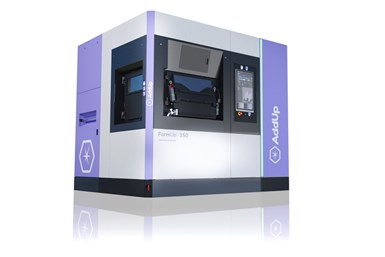Precision LPBF Improves Watch Component Part Performances
Partnering with AddUp has enabled watch part maker Kif Parechoc to use laser powder bed fusion to manufacture parts with improved mechanical performance using less material.

AddUp’s FormUp 350TM LPBF printer met the precision needs of Kif Parechoc’s watch clasps. The resulting parts showed improved mechanical properties to conventionally produced parts, as well as lower material usage. Photo Credit: AddUp
Kif Parechoc supplies shock absorbing systems, ratchets and barrels for Swiss and other European watchmakers. The company recently partnered with metal additive manufacturing specialist AddUp, testing modern metal AM techniques for high-precision work.
The first project resulting from this collaboration was a watch clasp made of low-carbon 316L stainless steel. “For this project, we started with a classic product but integrated new aspects, such as lattice structures, organic shapes and recessed markings,” explains Yoann Canon, industrial director of Kif Parechoc. The material is also already common in the watchmaking industry, on account of its high resistance to corrosion and good mechanical properties, which Maria Averyanova, head of luxury market development at AddUp, calls the “essential elements in the making of a watch.” This steel also does not lose its shine or tarnish over time, and is fully recyclable.
Better Production Through PBF
AddUp utilized laser powder bed fusion (LPBF) to manufacture the watch clasp, resulting in raw material savings, improved geometric complexity, and better heat exchange and other part performance indicators. This form of AM also enables Kif Parechoc to print several watch parts in a single operation, reducing assembly costs. According to Canon, the flexibility afforded by LPBF for the watch clasp parts “reduced the number of components to be assembled by a factor of two compared to equivalent products made using conventional techniques.”
The compatibility of AddUp’s FormUp 350TM with fine-grain metal powders proved particularly useful for this application. The company says these powders enable complex part production without supports and increase precision, while also providing smoother surface finishes than other metal LPBF machines.
“We are now working on the development of new post-treatment processes, adapted to the requirements of our industry and our production volumes,” Canon says. “At each stage of this project, AddUp was eager to collaborate. Between their mastery of the printing process and our knowledge of the products, and between their industrialization and our finishing operations, our companies complimented each other well.” The success of this partnership has led both companies to begin looking into creating parts and mechanisms new to the watchmaking world, and into developing new applications of metal additive manufacturing in the wider microtechnology and micromechanics industry.
Related Content
-
New Zeda Additive Manufacturing Factory in Ohio Will Serve Medical, Military and Aerospace Production
Site providing laser powder bed fusion as well as machining and other postprocessing will open in late 2023, and will employ over 100. Chief technology officer Greg Morris sees economic and personnel advantages of serving different markets from a single AM facility.
-
3D Printed NASA Thrust Chamber Assembly Combines Two Metal Processes: The Cool Parts Show #71
Laser powder bed fusion and directed energy deposition combine for an integrated multimetal rocket propulsion system that will save cost and time for NASA. The Cool Parts Show visits NASA’s Marshall Space Flight Center.
-
DMG MORI: Build Plate “Pucks” Cut Postprocessing Time by 80%
For spinal implants and other small 3D printed parts made through laser powder bed fusion, separate clampable units resting within the build plate provide for easy transfer to a CNC lathe.














